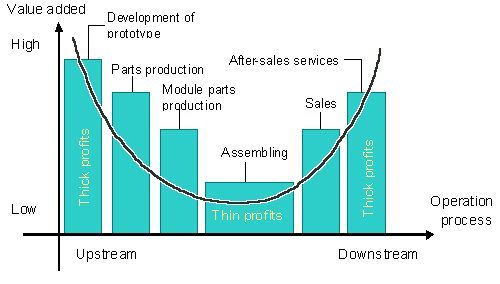Technological innovation in recent years in the form of modularization has brought drastic changes to the pattern of division of labor among companies, as well as among nations. Multinationals have been relocating their low value-added production processes to developing countries in pursuit of lower cost. China has taken this opportunity to establish itself as a major production base for multinationals. The fast pace of industrialization, however, has not been accompanied by a rapid increase in China's national income in dollar terms, as it have been forced to sell at lower and lower prices in international markets.
Modularization is to decompose industrial processes into segments, or modules. In the case of personal computers, for instance, respective modules such as a hard disk and a display are first produced separately, and then integrated into a complete system. In an industry where this modularity concept is widely applied, there exist established design rules and standards concerning the construction of respective modules. At the same time, modularization also provides flexibility to accommodate new methods of production within these rules. Processes within each module are independent from each other, neither affecting nor being affected by processes in other modules. This makes it far easier to place orders with different companies to undertake different production processes, or to become specialized in the production of a specific module.
Thanks to modularization of production, in many industries, the profitability at various stages of production has come to follow a U-shaped curve - high at the upstream and downstream processes and low at the midstream processes ( figure 1 ). Stan Shih, Chairman of Taiwan-based Acer Inc., is said to have first coined the term "smiling curve" to describe this phenomenon. Regarding personal computers, for example, value added is high at the upstream, which includes the development of operating systems (OS) and central processing units (CPU), and at the downstream, which includes maintenance services. Profitability is lowest in the midstream process, which involves such labor-intensive processes as assembly.
Modularization eliminates the need for a company to keep all the production processes in a single place or within the same company. Today, it is far more efficient to decompose production into a number of processes linked through a network of suppliers. Indeed, corporate and industrial reorganization has been taking place in a way that shifts away from the conventional integrated production system - typically from raw materials to finished products - to one concentrating resources on a specific area of strength. Likewise, business relations between companies are no longer limited to trade and capital participation, but also include such diversified forms as technology tie-ups and original equipment manufacturer (OEM) contracts.
Along with the progress in trade and investment liberalization in developing countries, inter- as well as intra-company production networks have become increasingly globalized. In accordance with respective countries' comparative advantages, labor-intensive processes tend to concentrate in developing countries that offer low wages, whereas high-tech processes, such as research and development (R&D), are undertaken by developed countries. As a result, there have been growing flows of trade in manufactured goods - especially of parts and intermediate goods - between developed and developing countries. This phenomenon has been called the "horizontal division of labor," as such exchanges are being made within the same industry. It had better be termed "vertical division of labor," however, given the way that processes are being divided between developed and developing countries respectively, with the former concentrating on high value-added and the latter on low value-added processes.
Against this backdrop, China has been taking advantage of its cheap and abundant labor to attract direct investment by multinationals, thereby accelerating the pace of industrial development. Exports of manufactured goods have increased sharply in recent years to account for 90 percent of China's overall exports in 2001. Processing trade, which represents roughly half the overall trade of China, has come to play a more important role in the Chinese economy. With its share of the world's manufactured exports rising, China has been widely recognized as the "factory of the world."
In terms of the smiling curve, however, the segment accessible to China (as well as other developing countries) is largely limited to the part around the tip of the chin, i.e., fields where value added is the lowest. Until the 1970s, as a newly industrializing country, Japan was fortunate that it did not have to compete with low-wage countries because manufacturing was highly concentrated in the industrial countries. Following the end of the Cold War and the integration of the former socialist countries into the global economy, however, cheap labor has become more readily available, and developing countries have been watching their profits fall amid intensifying competition. The smiling curve is thus getting steeper and steeper. For China, this means a decrease in the relative price of the labor services it provides against advanced technologies imported from developed countries, and a worsening of its terms of trade. In the sense that an increase in production has not necessarily led to an increase in real income, China is trapped in a grave situation of immiserizing growth. To set itself free from this trap to become a developed country, China must promote development focusing on the two ends of the smiling curve. But for this, improving the stock of human capital is vital, and China has a long way to go.
Figure 1: The smiling curve

(Reference) Aoki Masahiko and Ando Haruhiko. Mojuruka: Atarashii Sangyo Akitekucha no Honshitsu (Modularity: The Nature of New Industrial Architecture), RIETI Economic Policy Review 4, Toyo-Keizai Shimposha 2002.


